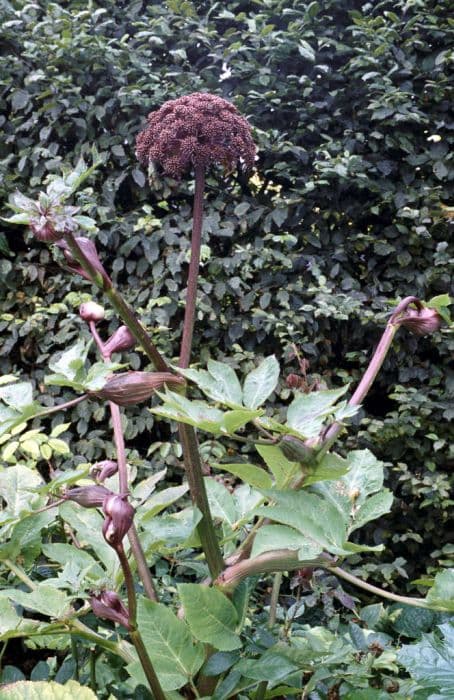Great Masterwort Astrantia major 'Star of Billion' (PBR)

ABOUT
The 'Star of Billion' is a particularly charming cultivar of Great Masterwort, boasting an elegant appearance that makes it a favorite among garden enthusiasts. The plant is adorned with delicate, pincushion-like flowers that display a unique star-shaped, geometric quality. Each bloom is composed of tiny, tightly clustered florets that are surrounded by a ruff of bracts, which are often mistaken for petals due to their showy nature. The flowers display a delightful color palette that can range from pale pink to a deep, dusky plum, creating a stunning visual contrast against the lush green foliage. The leaves of 'Star of Billion' are deeply lobed, resembling an open hand with fingers spread. They are broadly ovate and can have a green to bluish-green hue, providing a handsome backdrop to the ornamental flowers. In some cases, the leaf edges may exhibit a serrated or toothed margin, which adds to the texture of the plant. The overall appearance of the 'Star of Billion' exudes a cottage garden charm, with its intricate blooms and attractive foliage drawing in both human admirers and beneficial pollinators like bees and butterflies.
About this plant
 Names
NamesFamily
Apiaceae
Synonyms
Great Masterwort, Masterwort
Common names
Astrantia major 'Star of Billion' (PBR).
 Toxicity
ToxicityTo humans
Astrantia, commonly known as Masterwort, is not typically considered toxic to humans. There is no well-documented record of toxicity relating to Astrantia major, and it is generally regarded as safe to handle and be around. No symptoms of poisoning are commonly associated with this plant, suggesting that ingestion of reasonable quantities of any part of the plant is unlikely to lead to serious consequences or health hazards in humans. However, as with any plant, some individuals may experience allergic reactions or sensitivities, so it is always prudent to exercise caution if you are unfamiliar with a plant's effects on your health.
To pets
Masterwort is not known to be toxic to pets either. It is not typically listed on toxic plant databases for animals, and there are no widely recognized symptoms of poisoning in pets resulting from ingestion of Astrantia major. However, every pet is an individual, and what is non-toxic for one pet might still cause gastrointestinal upset in another. Thus, caution is advised when pets are around plants, but no specific toxic consequences are expected if a pet ingests parts of this particular plant.
 Characteristics
CharacteristicsLife cycle
Perennials
Foliage type
Deciduous
Color of leaves
Green
Flower color
White
Height
2 feet (60 cm)
Spread
1 foot (30 cm)
Plant type
Herb
Hardiness zones
5
Native area
Europe
Benefits
 General Benefits
General Benefits- Attractive Flowers: Produces star-like, pincushion flowers that add visual interest to gardens.
- Long Blooming Period: Offers a lengthy blooming season from early summer to early autumn.
- Wildlife Attraction: Attracts beneficial insects such as bees and butterflies, supporting local ecosystems.
- Low Maintenance: Requires minimal care once established, making it suitable for busy gardeners.
- Drought Tolerant: Can withstand periods of dry weather once established, reducing the need for frequent watering.
- Deer and Rabbit Resistant: Less likely to be eaten by deer and rabbits, which helps to maintain its appearance and health.
- Versatile Use: Suitable for borders, cottage gardens, and informal garden settings.
- Cut Flower: Makes an excellent cut flower for arrangements with its distinctive blooms and long vase life.
- Winter Interest: Provides garden interest even in the winter months with its seed heads and foliage.
 Medical Properties
Medical PropertiesThis plant is not used for medical purposes.
 Air-purifying Qualities
Air-purifying QualitiesThis plant is not specifically known for air purifying qualities.
 Other Uses
Other Uses- The Astrantia major 'Star of Billion', commonly known as Great Masterwort, can be used in pressed flower crafts for its intricate star-shaped blooms that maintain their shape and color well when dried.
- Great Masterwort can function as a natural fabric dye; its flowers can produce a range of subtle hues when used to dye textiles, offering an eco-friendly coloring alternative.
- The flower bracts and stems can be included in homemade potpourris as they hold their shape and add an interesting texture to the mix.
- Great Masterwort is sometimes used in floral photography due to its unique structure, providing an interesting focal point for macro photography studies.
- The seed heads of Astrantia major 'Star of Billion' can be spray-painted and used as decorative accents in wreaths and other dried floral arrangements.
- The plant can serve as an educational tool in botany classes to study the morphology and anatomy of umbelliferous flowers.
- Great Masterwort can be utilized in permaculture designs as part of a plant guild supporting beneficial insects that help maintain garden health.
- The blooms provide a natural, subtle fragrance to outdoor living spaces, enhancing the sensory experience of a garden without the use of artificial scents.
- When planted in large numbers, Great Masterwort can be used as a ground cover to prevent soil erosion in certain landscapes.
- Its distinctive geometric flower patterns can be used by artists and designers as inspiration for patterns in jewelry, textiles, and other decorative arts.
Interesting Facts
 Feng Shui
Feng ShuiThe plant_name is not used in Feng Shui practice.
 Zodiac Sign Compitability
Zodiac Sign CompitabilityThe plant_name is not used in astrology practice.
 Plant Symbolism
Plant Symbolism- Unity: The clustered flowers of the Astrantia, also known as Great Masterwort, symbolize coming together and unity, as they are a composite of many tiny flowers creating a single, harmonious head.
- Protection: Historically, Great Masterwort was believed to ward off evil and was used in spells for protection due to its intricate web of star-shaped blooms, suggesting a shield against harm.
- Perseverance: The plant's ability to grow in partially shaded environments and its robust nature embody the quality of perseverance, indicating the power to push through challenging conditions.
- Mystery and Complexity: With its complex star-shaped blooms and unique appearance, Great Masterwort can represent life’s mysteries and the intricate complexity of the universe.
 Water
WaterGreat Masterwort prefers consistent moisture, so watering should be done when the top inch of soil feels dry to the touch, typically once a week. During the growing season in spring and summer or in hotter periods, it may require water more frequently. Use a watering can or hose to gently water at the base of the plant, avoiding wetting the foliage, with about one to two gallons of water, ensuring the soil is moist but not waterlogged.
 Light
LightGreat Masterwort thrives best in partial shade, avoiding the intense heat of the midday sun. An ideal location would be one that receives morning sunlight and is shaded in the afternoon, or a spot that has dappled sunlight throughout the day. It can tolerate full sun in cooler climates, but the light conditions should always be more gentle than harsh to protect the plant's delicate foliage and blooms.
 Temperature
TemperatureGreat Masterwort can survive in a wide range of temperatures but prefers cooler conditions. It fares well in temperatures between 50°F and 75°F, which are often seen as ideal. However, it can handle temperatures as low as 20°F and as high as 80°F, though extremes on either end should be avoided to prevent stress on the plant.
 Pruning
PruningPruning Great Masterwort is necessary to remove spent flower stalks and encourage a second bloom, as well as to maintain the plant's shape. It should be pruned after the first flush of blooms in the summer. Deadheading regularly will also encourage more flowers. Cut back the foliage in late fall or early spring to tidy the plant and promote new growth.
 Cleaning
CleaningAs needed
 Soil
SoilGreat masterwort prefers a rich, moist, well-draining soil mix with a pH between 5.5 and 7.5. An ideal mixture can be made with garden soil, compost, and a small amount of gritty material like perlite to enhance drainage.
 Repotting
RepottingGreat masterwort does not need frequent repotting and can thrive for several years without being moved. Usually, repotting every 2 to 4 years is sufficient to refresh the soil and give the roots space to grow.
 Humidity & Misting
Humidity & MistingGreat masterwort enjoys moderate humidity levels but is quite adaptable and does not require specific humidity conditions. However, it thrives best in an environment that mimics its natural woodland habitat.
 Suitable locations
Suitable locationsIndoor
Place in bright, indirect light and ensure moist soil.
Outdoor
Plant in partial shade, keep soil moist, and protect from harsh sun.
Hardiness zone
4-9 USDA
 Life cycle
Life cycleThe Great Masterwort 'Star of Billion' begins its life when seeds are sown in late winter to spring in a cold frame, or established plants are divided in spring or fall. Germination leads to the development of a rosette of foliage where the plant will undergo vegetative growth, producing palmate leaves. As the temperature warms up in late spring to early summer, the plant enters the reproductive stage and develops branched stems topped with umbels of tiny flowers surrounded by bracts, giving the appearance of a single flower. After pollination by insects, the flowers produce seeds by late summer, which can disperse to propagate new plants. Throughout its life, the perennial plant will enter a period of dormancy during the winter months before resurging in spring. This cycle of growth, reproduction, and dormancy repeats annually, with plants potentially living for several years if conditions are favorable.
 Propogation
PropogationPropogation time
Early spring
Propogation: The most popular method of propagating Astrantia major 'Star of Billion', commonly known as Masterwort, is by division. This is best done in the spring or fall when the plant is not in active growth. To propagate by division, carefully lift the plant out of the ground with a garden fork, ensuring a generous amount of roots and soil are kept intact. Using a sharp spade, divide the plant into smaller sections, making sure each portion has at least one growing point or shoot and a good amount of roots. Replant the divisions at the same depth they were growing originally and water them in well. It is important to keep the new plantings moist until they are established, which typically takes a few weeks. This method of propagation allows gardeners to quickly increase their Masterwort plants while maintaining the genetic consistency of the 'Star of Billion' cultivar.









